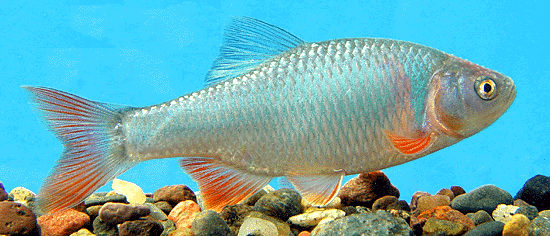Red Shiner
-
Scientific NameCyprinella lutrensis
-
NativeNo
-
Identification
 Red shiner. Caught in the Rock River, Rock County, Minnesota, in July 2002. Photo by Konrad Schmidt, Nongame Fish Biologist, Division of Ecological Services, Minnesota Department of Natural Resources.
Red shiner. Caught in the Rock River, Rock County, Minnesota, in July 2002. Photo by Konrad Schmidt, Nongame Fish Biologist, Division of Ecological Services, Minnesota Department of Natural Resources.- Deep, compressed body with a terminal mouth
- Breeding males have tubercles on their head, sides, and fins
- Buff to steely blue on back with silver on the sides and white on the belly
- Breeding males have red to orange caudal, anal, pelvic, and pectoral fins, steely blue sides, heads that are red on top and pinkish on the side, and purplish crescents behind the opercles
- 8 dorsal, 8-9 anal, 13-15 pectoral, and 8 pelvic fin rays
- 33-36 scales on a lateral line that curves down from the head
-
Life History
Red Shiners are adapted to, and most frequently found in, unstable environments that other species may have difficulty surviving in. This includes intermittent streams and highly disturbed, polluted areas like drainage ditches and certain reservoirs. They are capable of surviving in pHs from 4-11, salinities as high as 10ppt, dissolved oxygen levels as low as 1.5 mg/L, and temperatures as high as 39.5°C. They can also withstand rapid temperature shifts as dramatic as 21°C. In California there are two major populations with different habitat preferences. In the San Joaquin Valley turbid, alkaline, shallow, and slow moving streams are the preferred Red Shiner habitat. In contrast, the Colorado River finds the majority of its Red Shiners in backwaters and sloughs avoiding high currents. Overall, areas of silt and other fine substrates, less than 30 cm deep, with velocities between 10 and 50 cm/sec and vegetative cover are the most common locations for the species. Red Shiners swim in large schools during the day individually picking off whatever is prey is most abundant. This commonly means a diet high in small crustaceans, aquatic insect larvae, and surface insects but can also include larval fish when they are available and algae when other resources are limited.
Red Shiners are mature by their second summer and mate when temperatures are between 15°C and 30°C. In California this can make for a fairly long season, potentially May through October. Spawning occurs in slow moving water in both a territorial and group fashion. Non-territorial males will begin by chasing after a female in the school, often jumping out of the water as they go. After a meter or so, the two will settle down and begin swimming next to each other using the male’s tubercles to stay connected. Being fractional spawners, fecundity can vary but unspawned females have been found to hold 485-1,200 eggs. When laid, these eggs stick to plants, gravel, roots, logs, and other submerged debris but little is known about Red Shiners early life history beyond this. However, it is known that they will grow to between 25 mm and 30 mm by their first summer and grow another 5-15 mm over the next year reaching a maximum of 80 mm in 2.5 to 3 years.
-
Links to Other ResearchN / A
